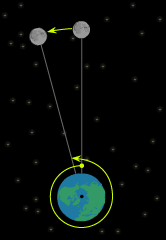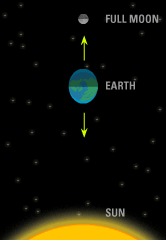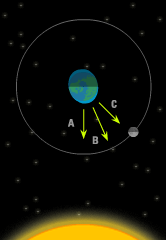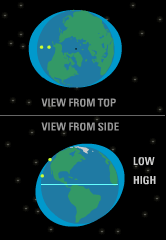
|
|
 Why is the tide cycle 24 hours 50 minutes long instead of
just 24 hours long?
Why is the tide cycle 24 hours 50 minutes long instead of
just 24 hours long?

You might think that, because the length of the tide cycle is
determined by the Earth's rotation, the tide cycle should be
24 hours long. The reason it's longer is that, during a
24-hour period, the moon travels about 12 degrees of its
360-degree orbit. The extra 50 minutes is how long it takes
any spot on the Earth to "catch up" to the moon's new
position.

|

|
|
 Why do the biggest tides happen when the moon is new and
full?
Why do the biggest tides happen when the moon is new and
full?

Although tides are affected mainly by the moon's gravity,
gravity from the sun also pulls on the oceans. In fact, the
tidal force of the sun is almost half (46%) that of the moon.
When the moon, sun, and Earth line up, we see either a full
moon (if we're between the moon and the sun) or a new moon (if
the moon is between us and the sun). At these times, the
gravitational forces of the sun and moon work together,
increasing the overall pull on the Earth and its oceans.

|

|
|
 Why do high tides sometimes precede the moon's zenith and
sometimes lag behind?
Why do high tides sometimes precede the moon's zenith and
sometimes lag behind?

If the tidal bulges only followed the moon, we'd always have a
high tide when the moon is at its zenith—its highest
point in its journey across the sky. But sometimes a high tide
precedes or lags the zenith by as much as several hours. The
reason is that the sun's gravity, in addition to influencing
the height of a tide, can also influence the position of the
bulges. For instance, as the moon approaches its first quarter
phase, the sun pulls back on the bulge. (In the image, A
represents the sun's gravitational tug, C the moon's, and B
the combined force of the two.) The Earth rotates into the
bulge earlier than it would have if the sun weren't pulling
back, causing the high tide to precede the moon's zenith. At
some points in the moon's orbit the sun pulls the bulge
forward, thus causing the tide to lag the moon's zenith.

|

|
|
 Why do some places on Earth experience only one high tide
(and one low tide) in a 24-hour period instead of two?
Why do some places on Earth experience only one high tide
(and one low tide) in a 24-hour period instead of two?

The moon doesn't orbit the Earth directly over the equator.
Instead, its orbit is inclined by about five degrees from a
line extending between our planet and the sun. Also, depending
on our position in our orbit around the sun, the moon's orbit
can be inclined by as much 23.5 degrees. This inclination
causes the tidal bulges to often form above and below the
equator. When this happens, it's possible for locations on the
rotating Earth to pass through only one of the two bulges,
thus producing only one high tide.

|
|
|
Note:
The following explanations take into account only basic
astronomical influences. They ignore geographical
influences, such as the presence of land masses, the
shape of coastlines, the varying depths and contours of
the seafloor, and weather.
|
|
|

